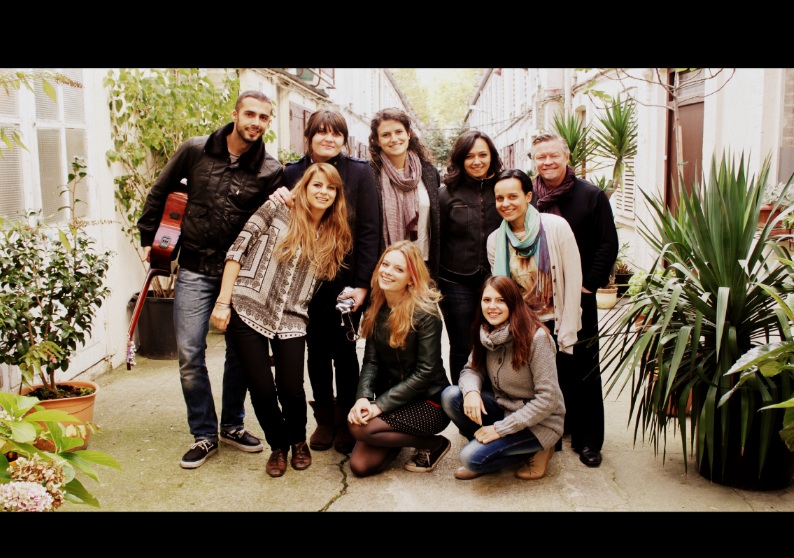What connects this year’s winners such as James Marsh’s documentary Man on Wire,
which charts Philippe Petit’s death-defying tightrope walk between the
twin towers in 1974 (Grand Jury Prize for World Cinema Documentary at
Sundance) to Doris Dorrie’s Cherry Blossoms, a story of an
elderly German widower who travels to Japan in search of his late
wife’s spirit in the foothills of Mount Fuji (Golden Space Needle Award
for Best Film at the Seattle International Film Festival)? Or Laurent
Cantet’s take on the Paris inner city schools based on François
Bégaudeau’s book of the same title Entre les Murs (Palme d’Or prize winner at Cannes) to Kylie Grey’s account of daily life for women in war-torn Iraq with the film My Home, Your War (ÉCU 2008 Best Foreign Documentary)? Is there something that threads these films together? A quality or a sentiment?
With these questions ringing in my ears, I headed to the local
FNAC in search of inspiration and a copy of my favourite independent
film of the last couple of years, the late Adrienne Shelly’s Waitress.
Her untimely death soon after the film finished shooting in November
2006, meant she never got to see the success that the film became. In
2007, Waitress won the Sarasota Film Festival Award in the
Narrative Feature category and was nominated for Best Screenplay at the
Independent Spirit Awards as well as being selected at both Deauville
and Sundance. Since her death, a foundation has been set up in her name
to support the work of women in the film industry. It is a fitting
tribute to such an inspiring filmmaker.
Although Adrienne is no longer here to tell us her thoughts on
the subject, maybe the answers can be found in her film. As I queued up
to pay I noticed the tagline on the cover of the French DVD version, 'En amour, il n’y a pas de recette’. There is no recipe for love. But can the same be said for film or is there a recipe for independent film success? Using Waitress as my guideline, I put it to the test.
Recipe for Independent Film
Preparation
Make Crust:
Prepare story using an unheard and original voice and let it develop until it is rich in both plot and character.
Shelly once described her film as a love letter to her daughter
Sophie, who she was pregnant with at the time of writing the
screenplay. What started as a letter developed into the story of Jenna,
a young waitress trapped in a miserable marriage to Earl, an overly
possessive thug who wants his dinner on the table and his wife by his
side. Jenna dreams of escaping but those thoughts are shattered when to
her horror, she discovers she is pregnant. Jenna subsequently embarks
on an unlikely affair with the new gynaecologist in town whilst
preoccupying herself with her real passion, making pies at the local
diner where she works. Begrudging her pregnancy right till the bitter
end, it is only when her daughter is born, that Jenna discovers true
love and finds the strength to follow her dream and leave her husband.
In a pre-Juno world, Shelly’s depiction of a fear-ridden
pregnancy is a refreshing change to Hollywood’s usual all-glowing,
all-loving take on maternity.
Make filling:
Whisk together a strong ensemble cast, a fitting
location with clear-sighted direction until it’s consistent in both
tone and style.
Waitress was shot on location in a real-life diner in
California in a mere 20 days. Shelly aimed at a maximum of 2 takes for
each shot. With so little room for error, it was her clarity of vision
that carried the film and made it possible. Not satisfied with only
directing and writing Waitress, Shelly also played the
supporting role of Dawn, a fellow waitress at the diner who falls in
love with a local man known for his outbursts of spontaneous poetry.
"They are poems that just occur to him on the spot. Last
night he said to me, "Dawn, your face is a brilliant moon in my empty
room. Your love is like a beating drum. Ba bum ba bum ba bum ba bum."
Shelley’s commitment to the project even went as far as writing
the soundtrack for the closing credits and her real-life daughter
Sophie played Jenna’s on-screen baby girl Lulu in the final scene. Her
style is evident throughout and gives the film consistency and flavour.
The pie-making provides the film with deliciously sensual visuals that
act as subtext to the plot and also give the film just some of its many
comic moments. ‘I hate my husband pie’ is proceeded by ‘bad baby pie’.
"I Hate My Husband Pie... You take bittersweet chocolate
and don't sweeten it. You make it into a pudding and drown it in
caramel".
Shelly’s assured sense of style seemed to rub off on the cast,
with every part of the ensemble clear about their own contribution.
Nathan Fillion, who plays Jenna’s gynaecologist and love-interest,
compared his role in the film to that of cinnamon in a good pie.
Individually, it doesn’t taste of much, but when you add it to the mix
it makes all the difference, bringing out the other flavours and
enhancing the pie as a whole.
Make topping:
Before serving to the general public,
edit the film with care. Submit your film to as many festivals as
possible and leave to cool.
I can’t ask Adrienne what her secret was but reading between the
lines of the song she wrote for the soundtrack, and staying with the
pie analogy, I imagine her answer to great filmmaking was simple.
"Baby don’t you cry, gonna make a pie, gonna make a pie with a heart in the middle."
So, whether it’s Man on Wire, Cherry Blossoms, My Home, Your War, Entre Les Murs
or countless other award-winning films, the one thing that unites all
of these celluloid triumphs is the love of the subject and of the
story. We can discuss what makes the perfect film but the best ones
speak for themselves. As the old saying goes ‘the proof is in the
pudding’.
Submissions are open for The European Independent Film Festival 2009. For more details go to the ECU website at www.ecufilmfestival.com
And for more information on the Adrienne Shelley foundation which promotes the work of women in the film industry go to www.adrienneshellyfoundation.org

























 Hillier Scott
Hillier Scott 


